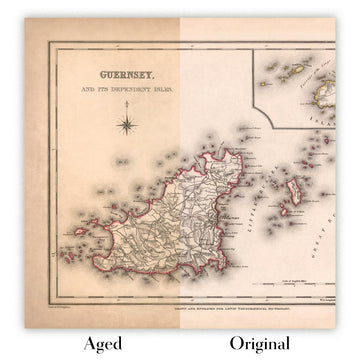

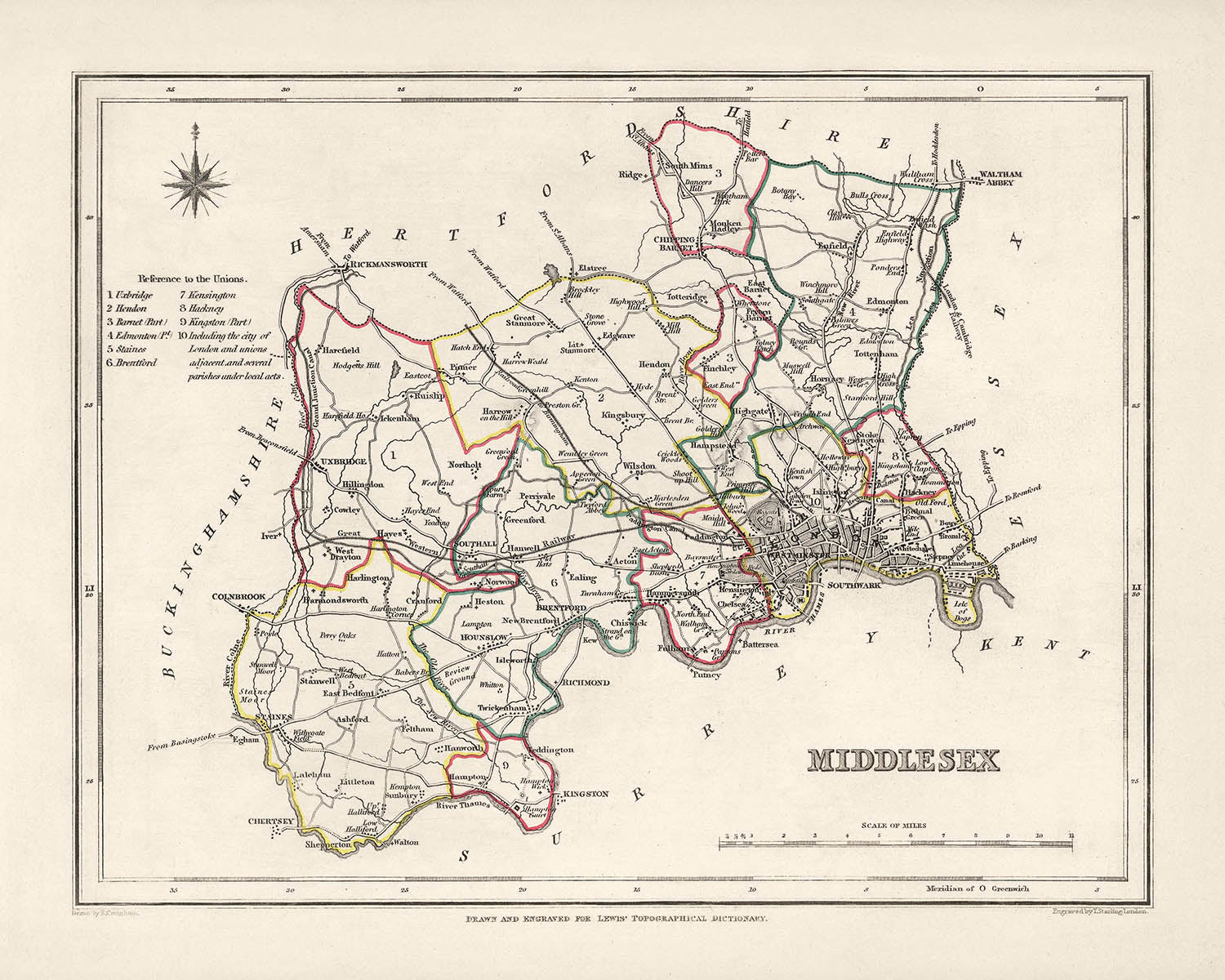

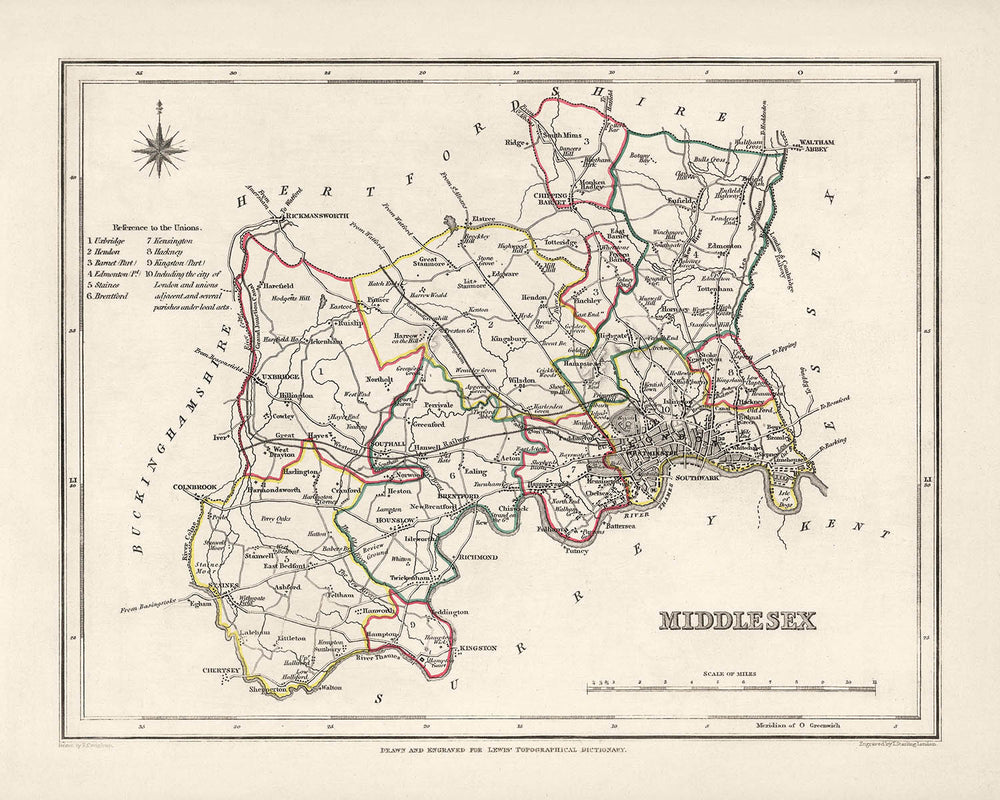

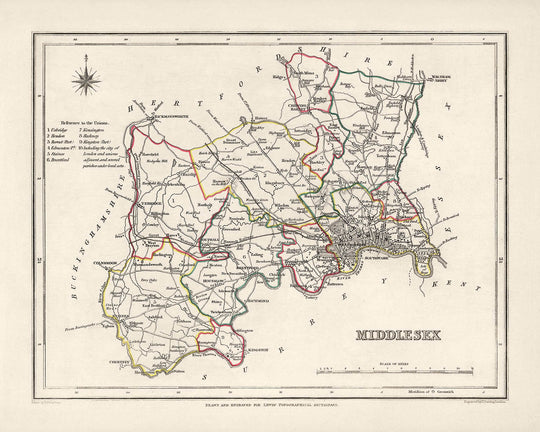







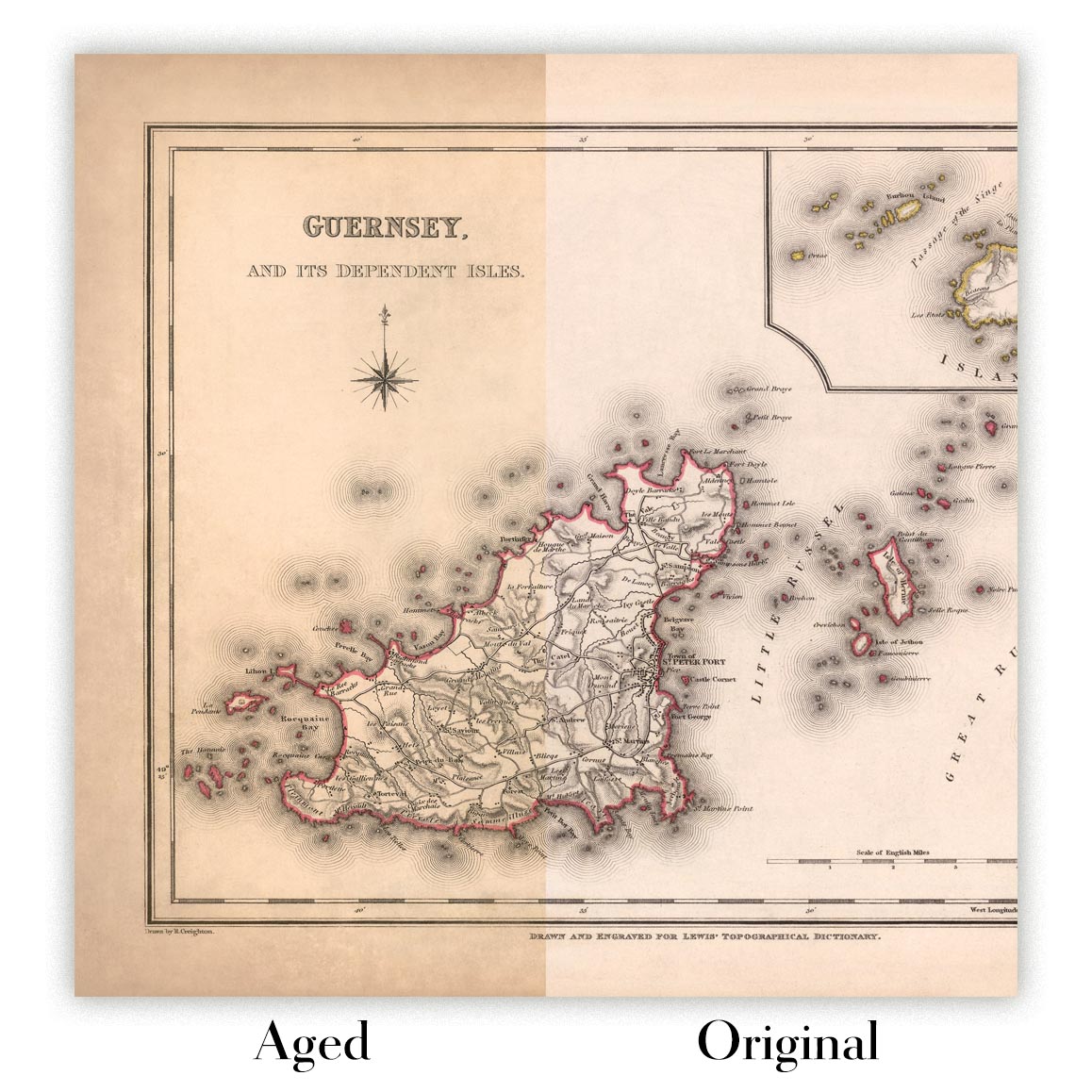



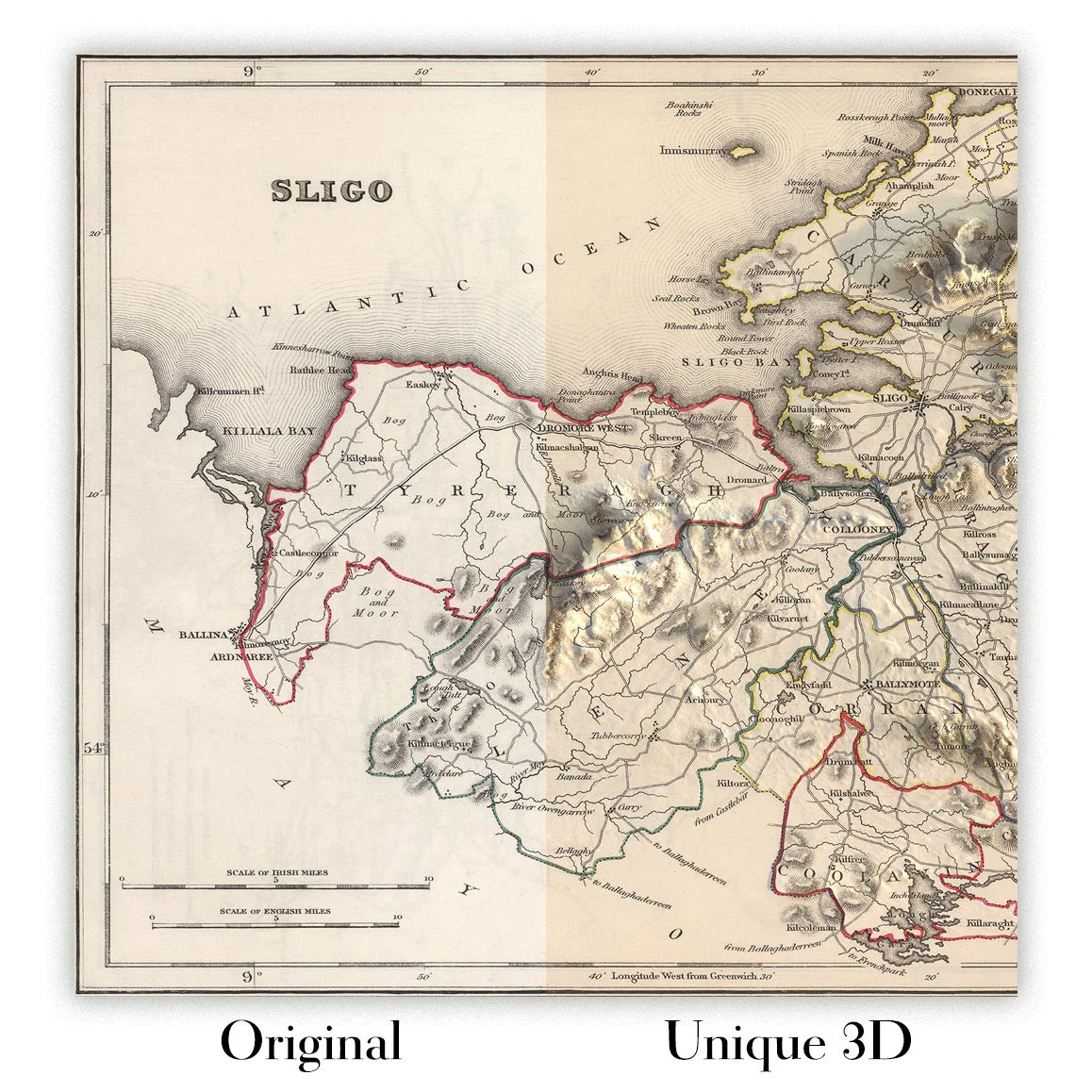



Old Map of Middlesex by Samuel Lewis, 1844: London, Westminster, Kensington, Chelsea, Richmond


-
![]() Handmade in Australia
Handmade in Australia
-
FREE worldwide delivery in 2-3 days ⓘ
Free Christmas delivery in 2-3 days
Your map should be delivered in 2-3 working days with free delivery, worldwide.
We make maps by hand locally in 23 countries, including Australia
![]() . If you're buying a gift for someone in another country, we will make the map locally to them.
. If you're buying a gift for someone in another country, we will make the map locally to them.You will never pay import tax or customs duty.
Check the Christmas delivery guide for order deadlines.
Express delivery is available at checkout which can reduce the delivery time to 1-2 days.
Please note that personalised maps, and larger framed maps, can take longer to produce and deliver.
If you need your order to arrive by a certain date, contact me and we can discuss your options.
-
90 day money back guarantee
ⓘ
90 days to return and refund
Products can be returned within 90 days for a full refund, or exchange for another product.
For personalised and custom made items, we may offer you store credit or a non-expiring gift card, as we cannot resell personalised orders.
If you have any questions, get in touch. For more information, see our full returns & exchanges policy.

My maps are rare, museum-grade, restored old maps sourced from libraries, auction houses and private collections across the globe.
Framing & free personalisation available
1. Select your size
➢ Pick the closest size (above)
➢ Provide the exact size in millimetres
➢ Add to bag and checkout as normal
2. Frame & personalise your map
Make your map unique with framing, hand-drawn customisation, vintage ageing, pop art text, unique 3D styling and moreGift message & custom finish

If you want to add a gift message, or a finish (jigsaw, aluminium board, etc.) that is not available here, please request it in the "order note" when you check out.
Every order is custom made, so if you need the size adjusted slightly, or printed on an unusual material, just let us know. We've done thousands of custom orders over the years, so there's (almost) nothing we can't manage.
You can also contact us before you order, if you prefer!

- Handmade locally. No import duty or tax
- FREE Delivery. Arrives in 2-3 days
- Love it or your money back
- Questions? WhatsApp me any time
Own a piece of history
5,000+ 5 star reviews


This Old Map of Middlesex by Samuel Lewis in 1844 is a captivating piece of history that offers a glimpse into the past. With its intricate details and exquisite craftsmanship, this map is a true work of art. It provides a unique opportunity to explore the County of Middlesex during the mid-19th century.
One of the fascinating aspects of this map is that it showcases the major towns and cities of Middlesex in 1844. It allows you to discover the historical names of these places, as some have undergone changes over time. While modern cities may not be featured on this map, it presents an exciting opportunity to see earlier names of locations that have evolved into bustling urban centers today.
Here is a list of 30 notable settlements, cities, and counties founded before 1840 within the historical boundaries of County of Middlesex:
- London (43 AD): The capital city of England, renowned for its rich history, iconic landmarks, and vibrant culture.
- Westminster (43 AD): Home to the Palace of Westminster and Westminster Abbey, this area has been at the heart of British politics and governance for centuries.
- Kensington (1086): Known for its elegant architecture and world-famous museums, Kensington is a symbol of refinement and cultural heritage.
- Chelsea (785): A neighborhood with a long-standing reputation for its artistic community, picturesque streets, and Chelsea Flower Show.
Richmond (1501): Nestled on the banks of the River Thames, Richmond boasts stunning landscapes, historic sites, and the beautiful Richmond Park.
Brentford (705): A historic market town with a strategic location along the River Thames, known for its industrial heritage.
- Edgware (1086): Tracing its roots back to the Domesday Book, Edgware is a suburban town with a rich history and charming character.
- Enfield (1086): A town with a royal history, Enfield is home to Enfield Palace and Enfield Market, which has been operating since 1303.
- Harrow (1086): Famous for its prestigious public school, Harrow School, this town has a long-standing educational tradition.
- Staines-upon-Thames (43 AD): Situated on the River Thames, Staines-upon-Thames is known for its historical bridges and riverside beauty.
- Uxbridge (1086): A market town with a significant role in the wool trade during the medieval period, Uxbridge is now a bustling suburban center.
- Twickenham (700): Renowned for its world-class rugby stadium and riverside charm, Twickenham is a popular destination for sports enthusiasts and nature lovers alike.
- Hounslow (1086): With its proximity to Heathrow Airport, Hounslow has become a major transportation hub while retaining its historical charm.
- Teddington (1086): Nestled on the banks of the River Thames, Teddington is known for its lock, which marks the tidal limit of the river.
- Greenford (848): A suburban town with a rich industrial heritage, Greenford is home to several notable factories and manufacturing sites.
- Hayes (1086): Historically an agricultural area, Hayes has transformed into a vibrant town with a diverse community and thriving businesses.
- Ruislip (1086): Surrounded by green spaces and ancient woodland, Ruislip offers a peaceful retreat from the bustling city life.
- Northolt (1086): A suburban town with a rich aviation history, Northolt is home to RAF Northolt, one of the oldest operational airfields in the UK.
- Southall (1086): Known for its vibrant South Asian community, Southall is a cultural melting pot with bustling markets and authentic cuisine.
- Acton (1086): With its mix of residential, commercial, and industrial areas, Acton has become a popular destination for young professionals.
- Willesden (939): A diverse and multicultural area, Willesden is known for its vibrant community, bustling markets, and beautiful parks.
- Pinner (1086): A picturesque village with a charming high street, Pinner offers a glimpse into Middlesex's rural past.
- Ealing (1086): A leafy suburban area with a rich architectural heritage, Ealing is known for its beautiful parks and vibrant community.
- Harlington (1086): Situated near Heathrow Airport, Harlington has a long history of hospitality and accommodation for travelers.
- Perivale (1086): Surrounded by open spaces and nature reserves, Perivale offers a peaceful escape from the urban hustle and bustle.
- Hanwell (1086): Home to the historic Hanwell Flight of locks, Hanwell is a picturesque area with a strong sense of community.
- West Drayton (1086): Located near Heathrow Airport, West Drayton has a rich history dating back to Roman times and offers convenient transport links.
- Yiewsley (1086): A charming village with a close-knit community, Yiewsley is known for its traditional pubs and tranquil atmosphere.
- Norwood Green (1086): Surrounded by green spaces and farmland, Norwood Green offers a rural retreat within easy reach of the city.
- Cowley (1086): With its historic buildings and picturesque setting, Cowley is a hidden gem that showcases Middlesex's rural beauty.
- Cranford (1086): Known for its beautiful parkland and historic buildings, Cranford offers a peaceful escape from the urban sprawl.
Notable boundaries, rivers, and natural phenomena in County of Middlesex, England include the River Thames, which flows through the heart of the county, dividing it into north and south banks. Additionally, the Grand Union Canal and the Brent River are prominent waterways that contribute to the region's charm. The county is also home to several parks and green spaces, such as Richmond Park, Bushy Park, and Osterley Park, which offer tranquil retreats amidst the bustling urban environment.
Between 1800 and 1850, the County of Middlesex witnessed significant historical events, including the construction of iconic landmarks such as the Houses of Parliament (begun in 1840) and the completion of the Thames Tunnel (opened in 1843), which was the world's first tunnel under a navigable river. The Industrial Revolution brought rapid urbanization and technological advancements to the region, transforming it into a thriving center of commerce, industry, and innovation.
Owning this Old Map of Middlesex by Samuel Lewis in 1844 allows you to delve into the county's rich history, explore its notable settlements, and appreciate the intricate details of a bygone era. It is a remarkable piece that captures the essence of Middlesex during a pivotal period of time.
Please double check the images to make sure that a specific town or place is shown on this map. You can also get in touch and ask us to check the map for you.
This map looks great at all sizes: 12x16in (30.5x41cm), 16x20in (40.5x51cm), 18x24in (45.5x61cm), 24x30in (61x76cm), 32x40in (81.5x102cm) and 40x50in (102x127cm), but it looks even better when printed large.
I can create beautiful, large prints of this map up to 50in (127cm). Please get in touch if you're looking for larger, customised or different framing options.
The model in the listing images is holding the 16x20in (40.5x51cm) version of this map.
The fifth listing image shows an example of my map personalisation service.
If you’re looking for something slightly different, check out my main collection of UK and Ireland maps.
Please contact me to check if a certain location, landmark or feature is shown on this map.
This would make a wonderful birthday, Christmas, Father's Day, work leaving, anniversary or housewarming gift for someone from the areas covered by this map.
This map is available as a giclée print on acid free archival matte paper, or you can buy it framed. The frame is a nice, simple black frame that suits most aesthetics. Please get in touch if you'd like a different frame colour or material. My frames are glazed with super-clear museum-grade acrylic (perspex/acrylite), which is significantly less reflective than glass, safer, and will always arrive in perfect condition.
This map is also available as a float framed canvas, sometimes known as a shadow gap framed canvas or canvas floater. The map is printed on artist's cotton canvas and then stretched over a handmade box frame. We then "float" the canvas inside a wooden frame, which is available in a range of colours (black, dark brown, oak, antique gold and white). This is a wonderful way to present a map without glazing in front. See some examples of float framed canvas maps and explore the differences between my different finishes.
For something truly unique, this map is also available in "Unique 3D", our trademarked process that dramatically transforms the map so that it has a wonderful sense of depth. We combine the original map with detailed topography and elevation data, so that mountains and the terrain really "pop". For more info and examples of 3D maps, check my Unique 3D page.
For most orders, delivery time is about 3 working days. Personalised and customised products take longer, as I have to do the personalisation and send it to you for approval, which usually takes 1 or 2 days.
Please note that very large framed orders usually take longer to make and deliver.
If you need your order to arrive by a certain date, please contact me before you order so that we can find the best way of making sure you get your order in time.
I print and frame maps and artwork in 23 countries around the world. This means your order will be made locally, which cuts down on delivery time and ensures that it won't be damaged during delivery. You'll never pay customs or import duty, and we'll put less CO2 into the air.
All of my maps and art prints are well packaged and sent in a rugged tube if unframed, or surrounded by foam if framed.
I try to send out all orders within 1 or 2 days of receiving your order, though some products (like face masks, mugs and tote bags) can take longer to make.
If you select Express Delivery at checkout your order we will prioritise your order and send it out by 1-day courier (Fedex, DHL, UPS, Parcelforce).
Next Day delivery is also available in some countries (US, UK, Singapore, UAE) but please try to order early in the day so that we can get it sent out on time.
My standard frame is a gallery style black ash hardwood frame. It is simple and quite modern looking. My standard frame is around 20mm (0.8in) wide.
I use super-clear acrylic (perspex/acrylite) for the frame glass. It's lighter and safer than glass - and it looks better, as the reflectivity is lower.
Six standard frame colours are available for free (black, dark brown, dark grey, oak, white and antique gold). Custom framing and mounting/matting is available if you're looking for something else.
Most maps, art and illustrations are also available as a framed canvas. We use matte (not shiny) cotton canvas, stretch it over a sustainably sourced box wood frame, and then 'float' the piece within a wood frame. The end result is quite beautiful, and there's no glazing to get in the way.
All frames are provided "ready to hang", with either a string or brackets on the back. Very large frames will have heavy duty hanging plates and/or a mounting baton. If you have any questions, please get in touch.
See some examples of my framed maps and framed canvas maps.
Alternatively, I can also supply old maps and artwork on canvas, foam board, cotton rag and other materials.
If you want to frame your map or artwork yourself, please read my size guide first.
My maps are extremely high quality reproductions of original maps.
I source original, rare maps from libraries, auction houses and private collections around the world, restore them at my London workshop, and then use specialist giclée inks and printers to create beautiful maps that look even better than the original.
My maps are printed on acid-free archival matte (not glossy) paper that feels very high quality and almost like card. In technical terms the paper weight/thickness is 10mil/200gsm. It's perfect for framing.
I print with Epson ultrachrome giclée UV fade resistant pigment inks - some of the best inks you can find.
I can also make maps on canvas, cotton rag and other exotic materials.
Learn more about The Unique Maps Co.
Map personalisation
If you're looking for the perfect anniversary or housewarming gift, I can personalise your map to make it truly unique. For example, I can add a short message, or highlight an important location, or add your family's coat of arms.
The options are almost infinite. Please see my map personalisation page for some wonderful examples of what's possible.
To order a personalised map, select "personalise your map" before adding it to your basket.
Get in touch if you're looking for more complex customisations and personalisations.
Map ageing
I have been asked hundreds of times over the years by customers if they could buy a map that looks even older.
Well, now you can, by selecting Aged before you add a map to your basket.
All the product photos you see on this page show the map in its Original form. This is what the map looks like today.
If you select Aged, I will age your map by hand, using a special and unique process developed through years of studying old maps, talking to researchers to understand the chemistry of aging paper, and of course... lots of practice!
If you're unsure, stick to the Original colour of the map. If you want something a bit darker and older looking, go for Aged.
If you are not happy with your order for any reason, contact me and I'll get it fixed ASAP, free of charge. Please see my returns and refund policy for more information.
I am very confident you will like your restored map or art print. I have been doing this since 1984. I'm a 5-star Etsy seller. I have sold tens of thousands of maps and art prints and have over 5,000 real 5-star reviews. My work has been featured in interior design magazines, on the BBC, and on the walls of dozens of 5-star hotels.
I use a unique process to restore maps and artwork that is massively time consuming and labour intensive. Hunting down the original maps and illustrations can take months. I use state of the art and eye-wateringly expensive technology to scan and restore them. As a result, I guarantee my maps and art prints are a cut above the rest. I stand by my products and will always make sure you're 100% happy with what you receive.
Almost all of my maps and art prints look amazing at large sizes (200cm, 6.5ft+) and I can frame and deliver them to you as well, via special oversized courier. Contact me to discuss your specific needs.
Or try searching for something!
This service is currently unavailable,
sorry for the inconvenience.
Pair it with a frame
Frame options are for visualization purposes only.
FRAME STYLE
MATTING SIZE
BUILDING YOUR EXPERIENCE
powered by Blankwall
Take a few steps back and let your camera see more of the scene.
powered by Blankwall
Was this experience helpful?
This Old Map of Middlesex by Samuel Lewis in 1844 is a captivating piece of history that offers a glimpse into the past. With its intricate details and exquisite craftsmanship, this map is a true work of art. It provides a unique opportunity to explore the County of Middlesex during the mid-19th century.
One of the fascinating aspects of this map is that it showcases the major towns and cities of Middlesex in 1844. It allows you to discover the historical names of these places, as some have undergone changes over time. While modern cities may not be featured on this map, it presents an exciting opportunity to see earlier names of locations that have evolved into bustling urban centers today.
Here is a list of 30 notable settlements, cities, and counties founded before 1840 within the historical boundaries of County of Middlesex:
- London (43 AD): The capital city of England, renowned for its rich history, iconic landmarks, and vibrant culture.
- Westminster (43 AD): Home to the Palace of Westminster and Westminster Abbey, this area has been at the heart of British politics and governance for centuries.
- Kensington (1086): Known for its elegant architecture and world-famous museums, Kensington is a symbol of refinement and cultural heritage.
- Chelsea (785): A neighborhood with a long-standing reputation for its artistic community, picturesque streets, and Chelsea Flower Show.
Richmond (1501): Nestled on the banks of the River Thames, Richmond boasts stunning landscapes, historic sites, and the beautiful Richmond Park.
Brentford (705): A historic market town with a strategic location along the River Thames, known for its industrial heritage.
- Edgware (1086): Tracing its roots back to the Domesday Book, Edgware is a suburban town with a rich history and charming character.
- Enfield (1086): A town with a royal history, Enfield is home to Enfield Palace and Enfield Market, which has been operating since 1303.
- Harrow (1086): Famous for its prestigious public school, Harrow School, this town has a long-standing educational tradition.
- Staines-upon-Thames (43 AD): Situated on the River Thames, Staines-upon-Thames is known for its historical bridges and riverside beauty.
- Uxbridge (1086): A market town with a significant role in the wool trade during the medieval period, Uxbridge is now a bustling suburban center.
- Twickenham (700): Renowned for its world-class rugby stadium and riverside charm, Twickenham is a popular destination for sports enthusiasts and nature lovers alike.
- Hounslow (1086): With its proximity to Heathrow Airport, Hounslow has become a major transportation hub while retaining its historical charm.
- Teddington (1086): Nestled on the banks of the River Thames, Teddington is known for its lock, which marks the tidal limit of the river.
- Greenford (848): A suburban town with a rich industrial heritage, Greenford is home to several notable factories and manufacturing sites.
- Hayes (1086): Historically an agricultural area, Hayes has transformed into a vibrant town with a diverse community and thriving businesses.
- Ruislip (1086): Surrounded by green spaces and ancient woodland, Ruislip offers a peaceful retreat from the bustling city life.
- Northolt (1086): A suburban town with a rich aviation history, Northolt is home to RAF Northolt, one of the oldest operational airfields in the UK.
- Southall (1086): Known for its vibrant South Asian community, Southall is a cultural melting pot with bustling markets and authentic cuisine.
- Acton (1086): With its mix of residential, commercial, and industrial areas, Acton has become a popular destination for young professionals.
- Willesden (939): A diverse and multicultural area, Willesden is known for its vibrant community, bustling markets, and beautiful parks.
- Pinner (1086): A picturesque village with a charming high street, Pinner offers a glimpse into Middlesex's rural past.
- Ealing (1086): A leafy suburban area with a rich architectural heritage, Ealing is known for its beautiful parks and vibrant community.
- Harlington (1086): Situated near Heathrow Airport, Harlington has a long history of hospitality and accommodation for travelers.
- Perivale (1086): Surrounded by open spaces and nature reserves, Perivale offers a peaceful escape from the urban hustle and bustle.
- Hanwell (1086): Home to the historic Hanwell Flight of locks, Hanwell is a picturesque area with a strong sense of community.
- West Drayton (1086): Located near Heathrow Airport, West Drayton has a rich history dating back to Roman times and offers convenient transport links.
- Yiewsley (1086): A charming village with a close-knit community, Yiewsley is known for its traditional pubs and tranquil atmosphere.
- Norwood Green (1086): Surrounded by green spaces and farmland, Norwood Green offers a rural retreat within easy reach of the city.
- Cowley (1086): With its historic buildings and picturesque setting, Cowley is a hidden gem that showcases Middlesex's rural beauty.
- Cranford (1086): Known for its beautiful parkland and historic buildings, Cranford offers a peaceful escape from the urban sprawl.
Notable boundaries, rivers, and natural phenomena in County of Middlesex, England include the River Thames, which flows through the heart of the county, dividing it into north and south banks. Additionally, the Grand Union Canal and the Brent River are prominent waterways that contribute to the region's charm. The county is also home to several parks and green spaces, such as Richmond Park, Bushy Park, and Osterley Park, which offer tranquil retreats amidst the bustling urban environment.
Between 1800 and 1850, the County of Middlesex witnessed significant historical events, including the construction of iconic landmarks such as the Houses of Parliament (begun in 1840) and the completion of the Thames Tunnel (opened in 1843), which was the world's first tunnel under a navigable river. The Industrial Revolution brought rapid urbanization and technological advancements to the region, transforming it into a thriving center of commerce, industry, and innovation.
Owning this Old Map of Middlesex by Samuel Lewis in 1844 allows you to delve into the county's rich history, explore its notable settlements, and appreciate the intricate details of a bygone era. It is a remarkable piece that captures the essence of Middlesex during a pivotal period of time.
Please double check the images to make sure that a specific town or place is shown on this map. You can also get in touch and ask us to check the map for you.
This map looks great at all sizes: 12x16in (30.5x41cm), 16x20in (40.5x51cm), 18x24in (45.5x61cm), 24x30in (61x76cm), 32x40in (81.5x102cm) and 40x50in (102x127cm), but it looks even better when printed large.
I can create beautiful, large prints of this map up to 50in (127cm). Please get in touch if you're looking for larger, customised or different framing options.
The model in the listing images is holding the 16x20in (40.5x51cm) version of this map.
The fifth listing image shows an example of my map personalisation service.
If you’re looking for something slightly different, check out my main collection of UK and Ireland maps.
Please contact me to check if a certain location, landmark or feature is shown on this map.
This would make a wonderful birthday, Christmas, Father's Day, work leaving, anniversary or housewarming gift for someone from the areas covered by this map.
This map is available as a giclée print on acid free archival matte paper, or you can buy it framed. The frame is a nice, simple black frame that suits most aesthetics. Please get in touch if you'd like a different frame colour or material. My frames are glazed with super-clear museum-grade acrylic (perspex/acrylite), which is significantly less reflective than glass, safer, and will always arrive in perfect condition.








